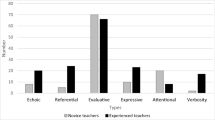Abstract
This article reports first steps in an analysis of teacher language in ELT classrooms which are being filmed in German secondary schools. With the tools of discourse and conversation analysis the focus is on teachers’ questions in their instructional context. Teachers’ questions can perform a range of different functions both in the various communicative and pedagogical situations in a lesson and within the IRF cycle (i.e. initiation, response, feedback/follow-up). We argue that even cognitively simple questions should not be discounted as they might serve an important function in the language learning process. Finally, we suggest a reassessment of the IRF cycle on the basis of our findings and we propose a re-working of Nunn’s (1999) framework for question analysis as a point of departure.
Access this chapter
Tax calculation will be finalised at checkout
Purchases are for personal use only
Similar content being viewed by others
Notes
- 1.
In Realschule pupils work towards an intermediate school certificate.
- 2.
High school or grammar school equivalent.
References
Anderson, L. and D. Krathwohl. 2001. A Taxonomy for learning, teaching and assessing. A revision of Bloom’s taxonomy of educational objectives. (abridged edition). New York: Longman.
Ashford, S. 2006. Green line new 4. Ausgabe für Bayern. Stuttgart: Klett Verlag.
Banbrook, L. 1987. Questions about questions: an enquiry into teachers’ questioning behaviour in ESL classrooms. TESOL Quarterly 20: 47–59.
Banbrook, L. and P. Skehan. 1990. Classrooms and display questions. In Research in the language classroom, eds. C. Brumfit and R. Mitchell. ELT Documents 133, British Council.
Brock, C.A. 1986. The Effects of Referential Questions on ESL Classroom Discourse. TESOL Quarterly 20: 47 – 59.
DIPF. Deutsches Institut für Internationale Pädagogische Forschung (ed.). 2007. DESI. Unterricht und Kompetenzerwerb in Deutsch und Englisch. Zentrale Befunde der Studie Deutsch Englisch Schülerleistungen International. (Retrieved December 8, 2011, from www.dipf.de/desi/DESI_Zentrale_Befunde.pdf).
Ellis, R. 1997. The study of second language acquisition. Oxford: Oxford University Press.
Johnson, K. 1995. Understanding communication in second language classrooms. Cambridge: Cambridge University Press.
Long, M. H. and C. J. Sato. 1983. Classroom foreigner talk discourse: Forms and functions of teachers’ questions. In Classroom oriented research in second language acquisition, eds. H. Seliger and M. Long, 268–285. Rowley, MA: Newbury House.
Nicula, T. 2007. The IRF pattern and space for interaction: comparing CLIL and EFL classrooms. In Empirical perspectives on CLIL classroom discourse, eds. C. Dalton-Puffer and U. Smit, 179–204. Frankfurt am Mein: Peter Lang.
Nunn, R. 1999. The purpose of language teachers’ questions. IRAL 37: 23–42.
Rivers, W. and M. S. Temperley. 1978. A practical guide to the teaching of English as a second or foreign language. New York: Oxford University Press.
Seedhouse, P. 2004. The interactional architecture of the language classroom: A conversation analysis perspective. Oxford: Blackwell.
Seedhouse, P. and S. Walsh. 2010. Learning a second language through classroom interaction. In Conceptualizing ‘learning’ in applied linguistics, eds. P. Seedhouse, S. Walsh and C. Jenks, 127–146. Basingstoke: Palgrave Macmillan.
van Lier, L. 1988. The classroom and the language learner. London: Longman.
White, J. and P. Lightbown. 1984. Asking and answering in ESL classes. Canadian Modern Language Review 40: 228–244.
Wong, R. 2010. Classifying teacher questions in EFL classrooms: Question types and their proper use. TESOL in Context 20: 37–57.
Author information
Authors and Affiliations
Corresponding author
Editor information
Editors and Affiliations
Rights and permissions
Copyright information
© 2014 Springer International Publishing Switzerland
About this chapter
Cite this chapter
Kirchhoff, P., Klippel, F. (2014). On the Role of Teacher Questions in EFL Classrooms: Analysing Lesson Videos. In: Pawlak, M., Bielak, J., Mystkowska-Wiertelak, A. (eds) Classroom-oriented Research. Second Language Learning and Teaching. Springer, Heidelberg. https://doi.org/10.1007/978-3-319-00188-3_6
Download citation
DOI: https://doi.org/10.1007/978-3-319-00188-3_6
Published:
Publisher Name: Springer, Heidelberg
Print ISBN: 978-3-319-00187-6
Online ISBN: 978-3-319-00188-3
eBook Packages: Humanities, Social Sciences and LawEducation (R0)




